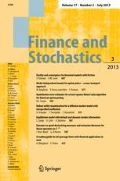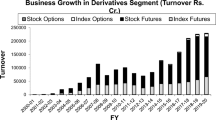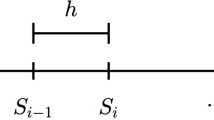Abstract
In this paper, we give sufficient conditions guaranteeing the validity of the well-known minimax theorem for the lower Snell envelope. Such minimax results play an important role in the characterisation of arbitrage-free prices of American contingent claims in incomplete markets. Our conditions do not rely on the notions of stability under pasting or time-consistency and reveal some unexpected connection between the minimax result and path properties of the corresponding process of densities. We exemplify our general results in the case of families of measures corresponding to diffusion exponential martingales.
Similar content being viewed by others
References
Aliprantis, C.D., Border, K.C.: Infinite Dimensional Analysis, 3rd edn. Springer, Berlin (2006)
Amarante, M.: A characterization of exact non-atomic market games. J. Math. Econ. 54, 59–62 (2014)
Bayraktar, E., Karatzas, I., Yao, S.: Optimal stopping for dynamic convex risk measures. Ill. J. Math. 54, 1025–1067 (2010)
Bayraktar, E., Yao, S.: Optimal stopping for non-linear expectations—part I. Stoch. Process. Appl. 121, 185–211 (2011)
Bayraktar, E., Yao, S.: Optimal stopping for non-linear expectations—part II. Stoch. Process. Appl. 121, 212–264 (2011)
Belomestny, D., Krätschmer, V.: Optimal stopping under model uncertainty: a randomized stopping times approach. Ann. Appl. Probab. 26, 1260–1295 (2016)
Belomestny, D., Krätschmer, V.: Addendum to “Optimal stopping under model uncertainty: a randomized stopping times approach”. Ann. Appl. Probab. 27, 1289–1293 (2017)
Belomestny, D., Krätschmer, V.: Optimal stopping under probability distortions and law invariant coherent risk measures. Math. Oper. Res. 42, 806–833 (2017)
Cheng, X., Riedel, F.: Optimal stopping under ambiguity in continuous time. Math. Financ. Econ. 7, 29–68 (2013)
Delbaen, F.: The structure of \(m\)-stable sets and in particular of the set of risk neutral measures. In: Émery, M., Yor, M. (eds.) Séminaire de Probabilités XXXIX, in Memoriam Paul-André Meyer. Lecture Notes in Mathematics, vol. 1874, pp. 215–258. Springer, Berlin (2006)
Föllmer, H., Schied, A.: Stochastic Finance, 3rd edn. De Gruyter, Berlin, New York (2011)
Giné, E., Nickl, R.: Mathematical Foundations of Infinite-Dimensional Statistical Models. Cambridge University Press, Cambridge (2016)
Karatzas, I., Kou, S.G.: Hedging American contingent claims with constrained portfolios. Finance Stoch. 2, 215–258 (1998)
Karatzas, I., Zamfirescu, I.-M.: Game approach to the optimal stopping problem. Stochastics 77, 401–435 (2005)
Kingman, J.F.C., Robertson, A.P.: On a theorem of Lyapunov. J. Lond. Math. Soc. 43, 347–351 (1968)
Kobylanski, M., Quenez, M.-C.: Optimal stopping time problem in a general framework. Electron. J. Probab. 17, 1–28 (2012)
König, H.: On some basic theorems in convex analysis. In: Korte, B. (ed.) Modern Applied Mathematics—Optimization and Operations Research, pp. 107–144. North-Holland, Amsterdam (1982)
König, H.: Measure and Integration. Springer, Berlin/Heidelberg (1997)
König, H.: Sublinear functionals and conical measures. Arch. Math. 77, 56–64 (2001)
Kremp, S.: An elementary proof of the Eberlein–Šmulian theorem and the double limit criterion. Arch. Math. 47, 66–69 (1986)
Revuz, D., Yor, M.: Continuous Martingales and Brownian Motion. Corrected, 3rd edn. Springer, Berlin (1999)
Simons, S.: A convergence theorem with boundary. Pac. J. Math. 40, 703–708 (1972)
Treviño-Aguilar, E.: American Options in Incomplete Markets: Upper and Lower Snell Envelopes and Robust Partial Hedging. Ph.D. thesis, Humboldt University at Berlin (2008). Available online at https://edoc.hu-berlin.de/handle/18452/16472
Treviño-Aguilar, E.: Optimal stopping under model uncertainty and the regularity of lower Snell envelopes. Quant. Finance 12, 865–871 (2012)
Viens, F.G., Vizcarra, A.B.: Supremum concentration inequality and modulus of continuity for sub-\(n\)th chaos processes. J. Funct. Anal. 248, 1–26 (2007)
Wilansky, A.: Topology for Analysis. Ginn, Waltham (1970)
Acknowledgements
The authors would like to thank Mikhail Urusov for fruitful discussions and helpful remarks. We are also grateful to some anonymous referee and the Co-Editor Alexander Schied for valuable suggestions to improve the presentation.
Author information
Authors and Affiliations
Corresponding author
Additional information
The first author’s work was supported by the Russian Academic Excellence Project “5–100.”
Appendix A: Paths of nearly sub-Gaussian random fields
Appendix A: Paths of nearly sub-Gaussian random fields
Let \((\Theta ,d)\) be some totally bounded semimetric space with diameter \(\Delta \). For \(\delta , \varepsilon > 0\), the symbols \(\mathcal{D}( \delta ,d)\) and \(N(\Theta ,d;\varepsilon )\) are used in an analogous manner as the notations \(\mathcal{D}(\delta ,d_{\Theta })\) and \(N(\Theta ,d_{\Theta };\varepsilon )\) from Sect. 3. We call a centered stochastic process \((X^{\theta })_{\theta \in \Theta }\) a nearly sub-Gaussian random field with respect to\(d\) if there is some \(C \geq 1\) with
Note that by symmetry, condition (A.1) also holds for arbitrary \(\lambda \in \mathbb{R}\). For \(C = 1\), this definition reduces to the ordinary notion of sub-Gaussian random fields. For further information on sub-Gaussian random fields, see e.g. [12, Sect. 2.3]. By a suitable change of the semimetric, we may describe any nearly sub-Gaussian random field as a sub-Gaussian random field.
Lemma A.1
If\((X^{\theta })_{\theta \in \Theta }\)is a nearly sub-Gaussian random field with respect to\(d\), then it is a sub-Gaussian random field with respect to\(\overline{d} := \varepsilon d\)for some\(\varepsilon > 1\).
Proof
Let \(C > 1\) be such that \((X^{\theta })_{\theta \in \Theta }\) satisfies (A.1). Then \(\varepsilon := \sqrt{12(2 C + 1)}\) is as required (cf. [12, Lemma 2.3.2]). □
The following properties of sub-Gaussian random fields are fundamental.
Proposition A.2
Let\(X = (X^{\theta })_{\theta \in \Theta }\)be a nearly sub-Gaussian random field on some probability space\((\overline{\Omega },\overline{ \mathcal{F}},\overline{\mathrm{P}})\)with respect to\(d\). If\(\mathcal{D}(\Delta ,d) < \infty \), then\(X\)admits a separable version, and each separable version of\(X\)has\(\overline{\mathrm{P}}\)-almost surely bounded and\(d\)-uniformly continuous paths. In particular, for any separable version\(\widehat{X}\)and for every\(\overline{\theta } \in \Theta \), there is some random variable\(U^{\overline{\theta }}\)on\((\overline{\Omega },\overline{\mathcal{F}},\overline{\mathrm{P}})\)such that
Proof
In view of Lemma A.1, we may assume without loss of generality that \(X\) is a sub-Gaussian random field with respect to \(d\). It is already known (see [12, Theorem 2.3.7]) that \(X\) admits a separable version, and that each such version has \(\overline{\mathrm{P}}\)-almost surely bounded and \(d\)-uniformly continuous paths. Now fix any separable version \(\widehat{X}\) of \(X\) and an arbitrary \(\overline{\theta }\in \Theta \). We have
and the process \((|\widehat{X}^{\theta } - \widehat{X}^{\overline{ \theta }}|)_{\theta \in \Theta }\) is separable due to the separability of \(\widehat{X}\). Then we may find some at most countable subset \(\Theta _{0}\subseteq \Theta \) such that
Hence \(U^{\overline{\theta }} := \sup _{\theta \in \Theta _{0}}|X^{ \theta } - X^{\overline{\theta }}|\) defines a random variable on \((\overline{\Omega },\overline{\mathcal{F}},\overline{\mathrm{P}})\) satisfying
It remains to show that \(\mathbb{E}_{\overline{\mathrm{P}}}[\exp (p U ^{\overline{\theta }})] < \infty \) for \(p\in (0,\infty )\). So fix \(p\in (0,\infty )\). First, observe that \(\widehat{X}\) is again a sub-Gaussian random field. Thus by [12, Lemma 2.3.1], we have
Hence we may apply the results from [25] with respect to the totally bounded semimetric \(\overline{d} := \sqrt{6}d\). Note that \((\widehat{X}^{\theta })_{\theta \in \Theta }\) is also separable with respect to \(\overline{d}\), and that \(\overline{ \Delta } = \sqrt{6}\Delta \) for the diameter \(\overline{\Delta }\) with respect to \(\overline{d}\). Since \(N(\Theta ,\overline{d};\varepsilon )\leq N(\Theta ,d;\varepsilon /\sqrt{6})\) for every \(\varepsilon > 0\), we obtain for every \(\delta > 0\) that
Then in view of [25, Corollary 3.2], we may find some constant \(C > 0\) such that
Furthermore, setting \(\widehat{C} := C\sqrt{6}{\mathcal{D}}(\Delta ,d)\), we may observe that
Then applying the change of variables formula several times, we obtain
Hence
which completes the proof. □
Rights and permissions
About this article
Cite this article
Belomestny, D., Hübner, T., Krätschmer, V. et al. Minimax theorems for American options without time-consistency. Finance Stoch 23, 209–238 (2019). https://doi.org/10.1007/s00780-018-0378-2
Received:
Accepted:
Published:
Issue Date:
DOI: https://doi.org/10.1007/s00780-018-0378-2
Keywords
- Minimax
- Lower Snell envelope
- Time-consistency
- Nearly sub-Gaussian random fields
- Metric entropies
- Simons’ lemma




